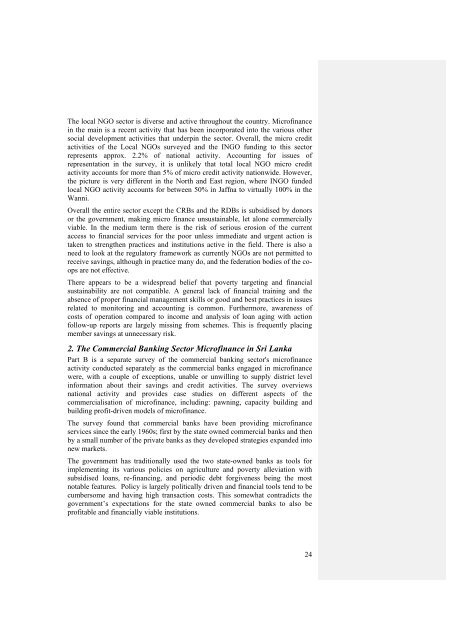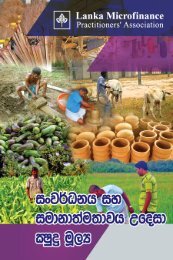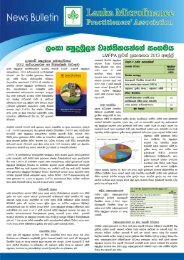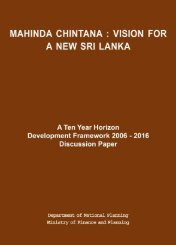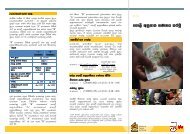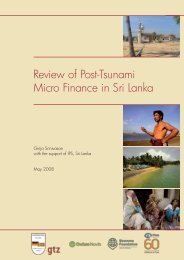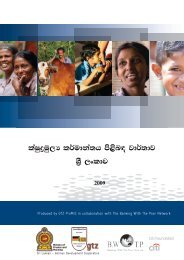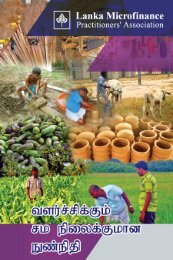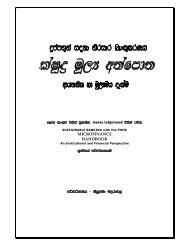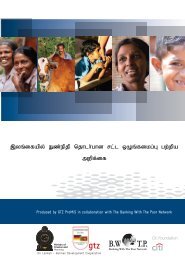National Microfinance Study of Sri Lanka: Survey of Practices and ...
National Microfinance Study of Sri Lanka: Survey of Practices and ...
National Microfinance Study of Sri Lanka: Survey of Practices and ...
You also want an ePaper? Increase the reach of your titles
YUMPU automatically turns print PDFs into web optimized ePapers that Google loves.
The local NGO sector is diverse <strong>and</strong> active throughout the country. <strong>Micr<strong>of</strong>inance</strong><br />
in the main is a recent activity that has been incorporated into the various other<br />
social development activities that underpin the sector. Overall, the micro credit<br />
activities <strong>of</strong> the Local NGOs surveyed <strong>and</strong> the INGO funding to this sector<br />
represents approx. 2.2% <strong>of</strong> national activity. Accounting for issues <strong>of</strong><br />
representation in the survey, it is unlikely that total local NGO micro credit<br />
activity accounts for more than 5% <strong>of</strong> micro credit activity nationwide. However,<br />
the picture is very different in the North <strong>and</strong> East region, where INGO funded<br />
local NGO activity accounts for between 50% in Jaffna to virtually 100% in the<br />
Wanni.<br />
Overall the entire sector except the CRBs <strong>and</strong> the RDBs is subsidised by donors<br />
or the government, making micro finance unsustainable, let alone commercially<br />
viable. In the medium term there is the risk <strong>of</strong> serious erosion <strong>of</strong> the current<br />
access to financial services for the poor unless immediate <strong>and</strong> urgent action is<br />
taken to strengthen practices <strong>and</strong> institutions active in the field. There is also a<br />
need to look at the regulatory framework as currently NGOs are not permitted to<br />
receive savings, although in practice many do, <strong>and</strong> the federation bodies <strong>of</strong> the coops<br />
are not effective.<br />
There appears to be a widespread belief that poverty targeting <strong>and</strong> financial<br />
sustainability are not compatible. A general lack <strong>of</strong> financial training <strong>and</strong> the<br />
absence <strong>of</strong> proper financial management skills or good <strong>and</strong> best practices in issues<br />
related to monitoring <strong>and</strong> accounting is common. Furthermore, awareness <strong>of</strong><br />
costs <strong>of</strong> operation compared to income <strong>and</strong> analysis <strong>of</strong> loan aging with action<br />
follow-up reports are largely missing from schemes. This is frequently placing<br />
member savings at unnecessary risk.<br />
2. The Commercial Banking Sector <strong>Micr<strong>of</strong>inance</strong> in <strong>Sri</strong> <strong>Lanka</strong><br />
Part B is a separate survey <strong>of</strong> the commercial banking sector's micr<strong>of</strong>inance<br />
activity conducted separately as the commercial banks engaged in micr<strong>of</strong>inance<br />
were, with a couple <strong>of</strong> exceptions, unable or unwilling to supply district level<br />
information about their savings <strong>and</strong> credit activities. The survey overviews<br />
national activity <strong>and</strong> provides case studies on different aspects <strong>of</strong> the<br />
commercialisation <strong>of</strong> micr<strong>of</strong>inance, including: pawning, capacity building <strong>and</strong><br />
building pr<strong>of</strong>it-driven models <strong>of</strong> micr<strong>of</strong>inance.<br />
The survey found that commercial banks have been providing micr<strong>of</strong>inance<br />
services since the early 1960s; first by the state owned commercial banks <strong>and</strong> then<br />
by a small number <strong>of</strong> the private banks as they developed strategies exp<strong>and</strong>ed into<br />
new markets.<br />
The government has traditionally used the two state-owned banks as tools for<br />
implementing its various policies on agriculture <strong>and</strong> poverty alleviation with<br />
subsidised loans, re-financing, <strong>and</strong> periodic debt forgiveness being the most<br />
notable features. Policy is largely politically driven <strong>and</strong> financial tools tend to be<br />
cumbersome <strong>and</strong> having high transaction costs. This somewhat contradicts the<br />
government’s expectations for the state owned commercial banks to also be<br />
pr<strong>of</strong>itable <strong>and</strong> financially viable institutions.<br />
24


